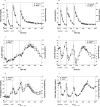Twenty-four-hour endocrine and metabolic profiles following consumption of high-fructose corn syrup-, sucrose-, fructose-, and glucose-sweetened beverages with meals
- PMID: 18469239
- PMCID: PMC3037416
- DOI: 10.1093/ajcn/87.5.1194
Twenty-four-hour endocrine and metabolic profiles following consumption of high-fructose corn syrup-, sucrose-, fructose-, and glucose-sweetened beverages with meals
Abstract
Background: We have reported that, compared with glucose-sweetened beverages, consuming fructose-sweetened beverages with meals results in lower 24-h circulating glucose, insulin, and leptin concentrations and elevated triacylglycerol (TG). However, pure fructose and glucose are not commonly used as sweeteners. High-fructose corn syrup (HFCS) has replaced sucrose as the predominant sweetener in beverages in the United States.
Objective: We compared the metabolic/endocrine effects of HFCS with sucrose and, in a subset of subjects, with pure fructose and glucose.
Design: Thirty-four men and women consumed 3 isocaloric meals with either sucrose- or HFCS-sweetened beverages, and blood samples were collected over 24 h. Eight of the male subjects were also studied when fructose- or glucose-sweetened beverages were consumed.
Results: In 34 subjects, 24-h glucose, insulin, leptin, ghrelin, and TG profiles were similar between days that sucrose or HFCS was consumed. Postprandial TG excursions after HFCS or sucrose were larger in men than in women. In the men in whom the effects of 4 sweeteners were compared, the 24-h glucose and insulin responses induced by HFCS and sucrose were intermediate between the lower responses during consumption of fructose and the higher responses during glucose. Unexpectedly, postprandial TG profiles after HFCS or sucrose were not intermediate but comparably high as after pure fructose.
Conclusions: Sucrose and HFCS do not have substantially different short-term endocrine/metabolic effects. In male subjects, short-term consumption of sucrose and HFCS resulted in postprandial TG responses comparable to those induced by fructose.
Figures



Similar articles
-
Endocrine and metabolic effects of consuming fructose- and glucose-sweetened beverages with meals in obese men and women: influence of insulin resistance on plasma triglyceride responses.J Clin Endocrinol Metab. 2009 May;94(5):1562-9. doi: 10.1210/jc.2008-2192. Epub 2009 Feb 10. J Clin Endocrinol Metab. 2009. PMID: 19208729 Free PMC article. Clinical Trial.
-
Effects of high-fructose corn syrup and sucrose consumption on circulating glucose, insulin, leptin, and ghrelin and on appetite in normal-weight women.Nutrition. 2007 Feb;23(2):103-12. doi: 10.1016/j.nut.2006.11.001. Nutrition. 2007. PMID: 17234503 Clinical Trial.
-
High-fructose corn syrup and sucrose have equivalent effects on energy-regulating hormones at normal human consumption levels.Nutr Res. 2013 Dec;33(12):1043-52. doi: 10.1016/j.nutres.2013.07.020. Epub 2013 Aug 30. Nutr Res. 2013. PMID: 24267044 Clinical Trial.
-
Endocrine and metabolic effects of consuming beverages sweetened with fructose, glucose, sucrose, or high-fructose corn syrup.Am J Clin Nutr. 2008 Dec;88(6):1733S-1737S. doi: 10.3945/ajcn.2008.25825D. Am J Clin Nutr. 2008. PMID: 19064538 Free PMC article. Review.
-
The metabolic and endocrine response and health implications of consuming sugar-sweetened beverages: findings from recent randomized controlled trials.Adv Nutr. 2013 Nov 6;4(6):677-86. doi: 10.3945/an.113.004580. eCollection 2013 Nov. Adv Nutr. 2013. PMID: 24228199 Free PMC article. Review.
Cited by
-
Impact of dietary carbohydrate type and protein-carbohydrate interaction on metabolic health.Nat Metab. 2021 Jun;3(6):810-828. doi: 10.1038/s42255-021-00393-9. Epub 2021 Jun 8. Nat Metab. 2021. PMID: 34099926
-
Glycation of human cortical and cancellous bone captures differences in the formation of Maillard reaction products between glucose and ribose.PLoS One. 2015 Feb 13;10(2):e0117240. doi: 10.1371/journal.pone.0117240. eCollection 2015. PLoS One. 2015. PMID: 25679213 Free PMC article.
-
A dual sugar challenge test for lipogenic sensitivity to dietary fructose.J Clin Endocrinol Metab. 2011 Mar;96(3):861-8. doi: 10.1210/jc.2010-2007. Epub 2011 Jan 20. J Clin Endocrinol Metab. 2011. PMID: 21252253 Free PMC article. Clinical Trial.
-
Cardiovascular risk and dietary sugar intake: is the link so sweet?Intern Emerg Med. 2012 Aug;7(4):313-22. doi: 10.1007/s11739-011-0606-7. Epub 2011 May 5. Intern Emerg Med. 2012. PMID: 21544534 Review.
-
Appetite-Regulating Hormones Are Reduced After Oral Sucrose vs Glucose: Influence of Obesity, Insulin Resistance, and Sex.J Clin Endocrinol Metab. 2021 Mar 8;106(3):654-664. doi: 10.1210/clinem/dgaa865. J Clin Endocrinol Metab. 2021. PMID: 33300990 Free PMC article. Clinical Trial.
References
-
- Bray GA, Nielsen SJ, Popkin BM. Consumption of high-fructose corn syrup in beverages may play a role in the epidemic of obesity. Am J Clin Nutr. 2004;79:537–43. - PubMed
-
- Havel PJ. Dietary fructose: implications for dysregulation of energy homeostasis and lipid/carbohydrate metabolism. Nutr Rev. 2005;63:133–57. - PubMed
-
- Guthrie JF, Morton JF. Food sources of added sweeteners in the diets of Americans. J Am Diet Assoc. 2000;100:43–51. quiz 49-50. - PubMed
-
- Gao X, Qi L, Qiao N, et al. Intake of added sugar and sugar-sweetened drink and serum uric acid concentration in US men and women. Hypertension. 2007;50:306–12. - PubMed
-
- Mundt CA, Baxter-Jones AD, Whiting SJ, Bailey DA, Faulkner RA, Mirwald RL. Relationships of activity and sugar drink intake on fat mass development in youths. Med Sci Sports Exerc. 2006;38:1245–54. - PubMed
Publication types
MeSH terms
Substances
Grants and funding
LinkOut - more resources
Full Text Sources
Medical
Miscellaneous

